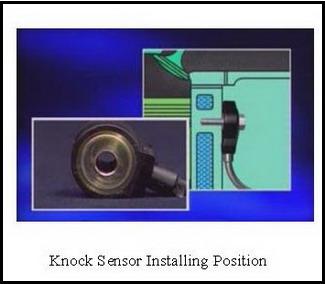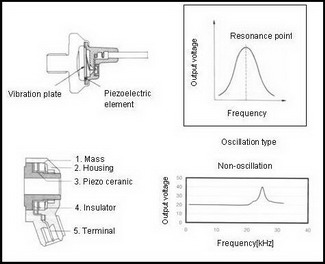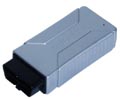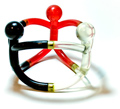- Knock Sensor
- |
- Sensors
- |
- Repair Basics
- |
- Technical Info
- |
- Car Tech Info
- |
- MicroTronik
Knock Sensor

Knock Sensor Installation

Knock Sensor Configuration
1) Outline
For efficiency of the engine, the engines of higher compression ratio are desirable. Higher compression ratio will raise engine efficiency, but on the other hand probability of knocking will rise too. Normal combustion in engine is affected by igniting air/fuel mixture with spark and then spreading inflamed flame front.However rapid combustion by self ignition may locally occur before flame front reaches normally. The abnormal combustion may generate rapid pressure rise that will vibrates gas in cylinder to generate shocking noise, which is called knocking. Knocking may be caused by combustion shape of the chamber and accumulated substances, mixture components, shape of intake manifold, fuel quality, air density and engine temperature. In addition ignition timing is closely related to knocking and too early ignition timing will cause knocking. Knocking will burn out spark plug, and piston, and damage cylinder head gasket, and bearing. So knocking must be avoided.
Engine knock control is used to constrain the knocking. Knock control detects knocking generated in engine and retard ignition timing.
2) Structure and Type
(1) Types of Knock SensorThe best way to detect knocking is to use pressure sensor that measures pressure in cylinder, but the sensor is expensive. Piezo-Ceramic sensor made as an integrated part with spark plug is also effective for detecting knocking, but the price is high and the endurance is poor, so that the sensor in not used significantly.
Knock sensor is using piezo electric effect of piezo-ceramic and is the most widely used for detecting knocking.
(2) Piezoelectric Effect
When external stress is applied piezo-ceramics such as quartz (SiO2), Barium fitanate (BaTiO3), and PZT (Pb(Zr.Ti)O3), electric charge is generated at both sides of the crystal. It is called piezoelectric effect. Installing electric at both sides of piezo-ceramics can detect electric charge generated by external stress.
3) Knock Sensor
Knock sensor is usually embedded on cylinder block. Oscillation generated by knock and transferred to cylinder block, will be converted to electric signal using piezoelectric effect type sensor.Two kinds of knock sensors are used:
Oscillation type sensors have the same oscillation characteristic at knock frequency bank; and non-oscillation type sensor is the opposite.
A. Oscillation Type Sensor
The sensor consists of vibrator that has almost same oscillation characteristic as knocking oscillation, and piezoelectric element that detects vibration pressure of the vibrator and then converts it to electrical signal. The sensor has designed to have high sensitivity at oscillation frequency.
In order to use oscillation type sensor, those products should have oscillation frequency same with knocking frequency of the engine. However each engine has its own specific knocking frequency and the application is hard enough to avoid being used currently.
B. Non-Oscillation Type Sensor
The sensor accommodates higher frequency (above 20 kHz) than knocking oscillation frequency of the vibration, has constant sensitivity at or below oscillation frequency. This type sensor will directly detect knocking vibration using piezoelectric element.
Non-oscillation knock sensor is designed to have oscillation frequency higher than knocking frequency of the engine, and products that have same characteristic irrespective to engine models may be applicable, and then widely used currently.
In case applying non-oscillation type knock sensor, band pass filter that has center frequency same as knocking frequency of the engine, is integrated in interface layer inside ECM.
4) The Installation Position of Knock Sensor
For precise detection of Knocking, it is desirable to install a knock sensor at each cylinder; however it will accompany higher cost.Therefore minimum number of knock sensor is used to detect all knocking occurred at each cylinder. Typically one knock sensor covers for cylinders and two knock sensors are used to cover six cylinders.
Knock sensors shall be installed where interference by noise and temperature effect may be minimized. For best example of deciding installing position of knock sensor,
5) Checking Procedure
Knock sensor shall be checked for connection contact condition and circuit-break and short. As the sensor is installed on cylinder block to detect vibration, the sensor shall be checked if installed with specified tightening torque. In addition, resistance value and electrostatic capacity between terminal 2 & 3 shall be measured and compared with specified values.6) Failure Symptom
The failure symptom is hard for drivers to sense particularly. In case of knock sensor failure, ignition timing will be controlled to be retarded by approx. 10 Degree, and then power may be low during acceleration or knocking may occur at higher load of engine.
You can check the sensor actual value and status by AutoHex automotive Diagnostic Scanner under the supported car brand and according to engine type.
BMW Key Programming F10, All keys Lost
Description
knock sensor is used to detect knocking generated in engine and retard ignition timing , and Knocking may be caused by the shape of combustion chamber and accumulated substances, mixture components,the shape of intake manifold, fuel quality, air density and engine temperature. and the sensor is installed on cylinder block to detect vibration.
Autohex II Reviews
AutoHex II
AutoHex II is your best choice to have full access to dealer functions like coding, adjusting and modules flashing/programming, Contact us for prices
AutoHex Forum


